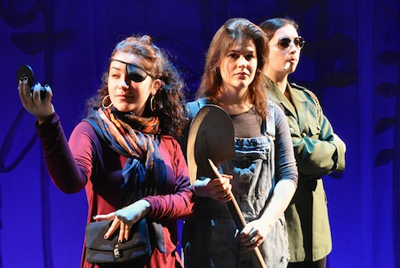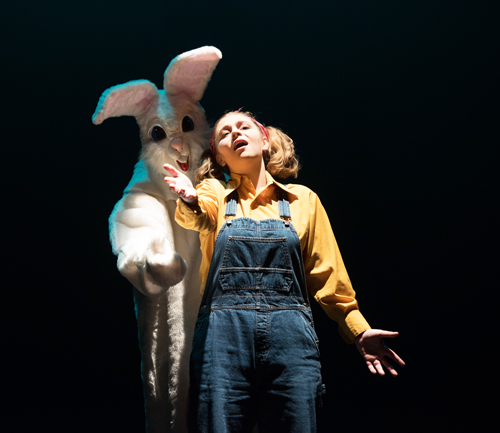by Mike Telin & Daniel Hathaway

Soprano Rebecca Achtenberg, who plays Sandrina, read four different synopses before she auditioned. “The plot is complicated and I have relished developing ways of explaining it as quickly as possible. But I think if you take out all of the side plots it is pretty simple: girl gets stabbed by her lover, girl goes off to find him, a lot of mistaken identity, a lot of love triangles, and finally, everybody ends up with the person they should. Of course, the intricacies are important to the fun, but I think the plot clears up as the characters develop throughout the opera.”
Soprano Elissa Pfaender, who sings the role of Arminda, said, “I think it’s an opera that you need to experience to truly understand what’s going on. It’s early Mozart, so it’s very different from Figaro, Così or Don Giovanni. But the story is so wild, and the music is so wonderful. Each character’s music is very defining.”
As in the case of many productions, Field has done a fair amount of cutting. “The recits have been trimmed down quite nicely. I think the cuts have made it into a neat, workable version of the opera. With some cuts, I’ve staged the missing action in the background anyway so the audience will be aware of everything that is going on. We did keep in something that is often cut — the mad scene in act three between the Count and Sandrina.”

Serpetta (Julie Crookston) & Nardo (Andrew Groble)
Field said that figuring out how to make that mad scene work was the key to unlocking everything. It gave him the idea for the rabbits — named Ralph, Rachel, Richard, Rebecca, Robert and Rosalie — who play such a big role in the opera’s garden. That notion came to Field last summer while tending his own plot of land. “We had a rabbit who would just sit there and munch away while both of our dogs ignored him. It was like he was invisible to them.
“I began to think that since there is a garden in the opera maybe there is a rabbit there too, and maybe the rabbit is like Puck, who helps things along. This became a motivation to get characters to do certain things. Soon the rabbits became spirit guides who would move people in the right direction. But of course, people being people, they always resist. The rabbits also help determine the seasons. This production travels through all four seasons, beginning with spring and ending with winter.”

Rabbit & Sandrina (Rose Kearin)
“The idea of the rabbits is a little creepy but it does work,” Pfaender said. “It’s fitting because everybody goes through a mental breakdown during the opera. Having these little voices in their heads is unexpected but it adds a fun touch.”
Cast members have been busy contemplating their roles. “I think the interesting thing about the Count, and maybe the Count and Sandrina together, is that the primary action their story revolves around is not actually part of the opera,” McGrew said. “The audience does know that at some point he has stabbed his lover, but by the time the Count enters, he’s like the person at the dinner party that you’ve heard a lot of crazy things about. But then he comes off as being remarkably normal — especially in this production, which is full of surprising elements.”
Achtenberg elaborated on how she developed the character of Sandrina. “At first, I had a hard time understanding her actions. Her lover stabs her and leaves her for dead, but she decides to go find him. I think she does this because she is young, he is her first love, and she just needs to be with him. There is a magnetism that pulls them together that even she can’t explain. On the other hand, 95% of what she does in the opera is complain. I’ve spent a lot of time trying to make her something other than dour, or perhaps even pathetic.”
The other woman who causes the Count grief is Arminda, his intended bride. “I like to describe her as a diva with a dark side,” Elissa Pfaender said. “She wants things to go a certain way, and when that doesn’t happen, her dark side comes out. I don’t want to say that she is the villain of the opera, since I think all of her motives come from a place of love. She does have that multiple personality disorder thing. She is neurotic. In one scene she has to be loving and endearing, then she finds out that something isn’t going her way and she freaks out. She even says, ‘Don’t you know that I’m testy and capricious?’ So she knows these things about herself. When somebody is so crazy, you just want to go there and explore that craziness. I’m having a lot of fun with this role.”

Count Belfiore (Daniel McGrew) & Arminda (Juliana Zara)
McGrew added, “Field has encouraged us to be excited about Arminda ‘s eccentricities, which adds another layer of darkness to everything.”
Summing up the characterizations, Jonathon Field noted that “much of the opera centers around the characters trying to reinvent themselves, and taking on new identities that will help them do that. In the end, they discover that forgiveness and acceptance is the best way to reinvent yourself. I think that was a theme Mozart was working on for most of his life.”
Daniel McGrew agrees. “I think most of us have found ourselves in a place where we have done something so incredibly wrong that we don’t feel that we can resolve or fix it. In that way, the Count is just a guy who is trying to move on.”
All details aside, La finta giardiniera is a delightful comic opera with a zany plot. Says Rebecca Achtenberg — who has to vocalize at one point from a swing — “If you suspend your disbelief, you’ll have a great time.”
Jarrett Hoffman contributed to this article.
Photos: Oberlin Conservatory/Yevhen Gulenko.
Published on ClevelandClassical.com March 9, 2015.
Click here for a printable copy of this article


